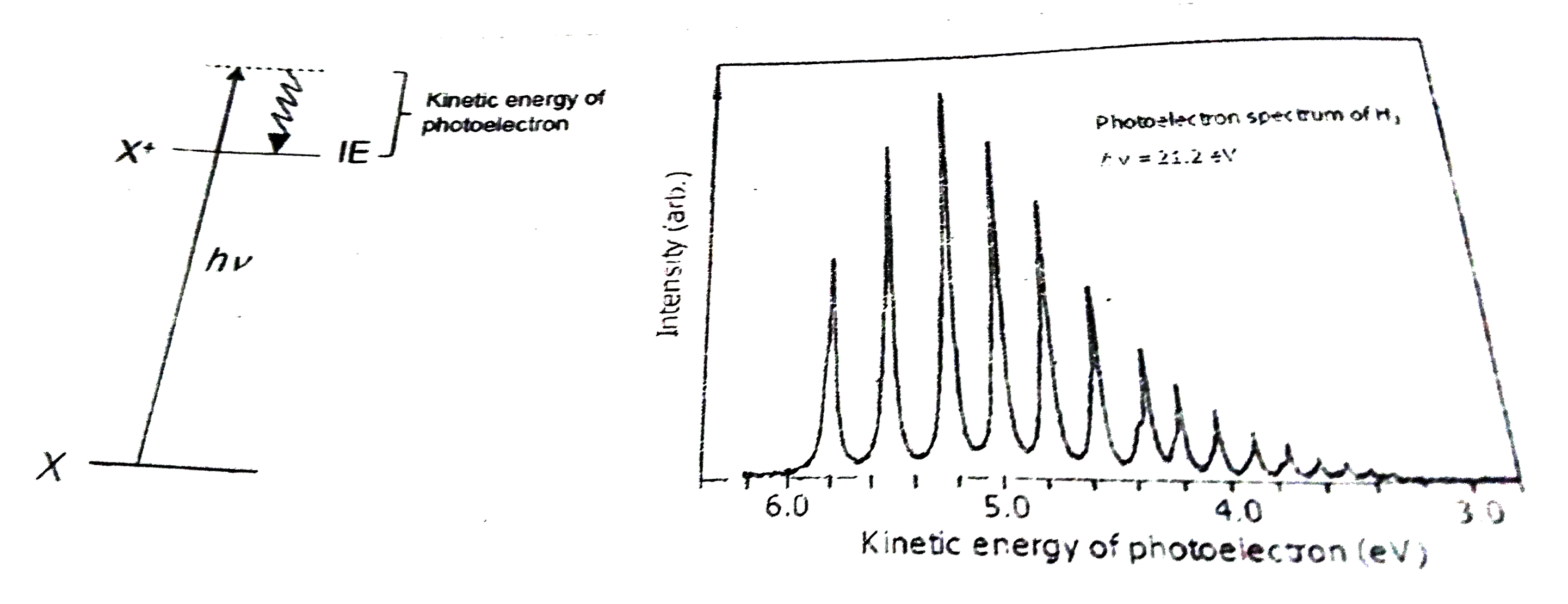When an atom X absorbs radiation with a photon energy than the ionization energy of the atom, the atom is ionized to generate an ion X+ and the electron (called a photoelectron) is ejected at the same time. In this event, the energy is conserved as shown in Figure 1, that is,
Photon energy (h)=ionization energy (IE) of X+ kinetic energy of photoelectron.
When a molecule, for example, H2, absorbs short-wavelength light, the photoelectron is ejected and an H2, ion with a variety of vibrational states is produced. A photoelectron spectrum is a plot of the number of photoelectrons as a function of the kinetic energy of the photoelectrons. Figure-2 shows a typical photoelectron spectrum when H2 in the lowest vibrational level is irradiated by monochromatic light of 21.2eV. No photoelectrons are detected above 6.0eV. (eV is a unit of energy and 1.0eV is equal to 1.6×10−19J)

Figure 1 Schematic diagram of photoelectron spectroscopy.
Figure 2 Photoelectron spectrum of H2. The energy of the incident light is 21.2eV
Calculate––––––––––– the speed u(ms−1) of the hydrogen atoms generated in the above reaction. H2 is assumed to be at rest. If you were unable to determine the value for EC, then use 5.0eV for EC
The correct Answer is:The excess energy is 16.7eV(=21.2eV−4.5eV). Because two hydrogen atoms are generated upon dissociation, half of this excess is released as translation energy of the hydrogen atoms.
12mu2=8.35eV=1.34×10−18J
Similar Questions
हाइड्रोजन परमाणु का आयनन-विभव 13.6 वोल्ट है। निम्नतम ऊर्जा-स्तर में यह परमाणु 800Å का फोटॉन अवशोषित करके आयनित हो जाता है। निकलने वाले इलेक्ट्रॉन की गतिज ऊर्जा क्या होगी?
View SolutionThe ratio of the third ionization energy of lithium and ionization energy of H atom is of H-atom and that of Li+2 ion is:
View Solution10 गुने आयनित सोडियम परमाणु की आयनन ऊर्जा होगी-
View Solutionहाइड्रोजन परमाणु की आयनन ऊर्जा 18.6ev है। हीलियम परमाणु की आयनन ऊर्जा कितनी होगी?
View SolutionThe ionization energy of 10 times the ionized sodium atom ......
View SolutionWhen an atom X absorbs radiation with a photon energy than the ionization energy of the atom, the atom is ionized to generate an ion X+ and the electron (called a photoelectron) is ejected at the same time. In this event, the energy is conserved as shown in Figure 1, that is,
Photon energy (h)=ionization energy (IE) of X+ kinetic energy of photoelectron.
When a molecule, for example, H2, absorbs short-wavelength light, the photoelectron is ejected and an H2, ion with a variety of vibrational states is produced. A photoelectron spectrum is a plot of the number of photoelectrons as a function of the kinetic energy of the photoelectrons. Figure-2 shows a typical photoelectron spectrum when H2 in the lowest vibrational level is irradiated by monochromatic light of 21.2eV. No photoelectrons are detected above 6.0eV. (eV is a unit of energy and 1.0eV is equal to 1.6×10−19J)

Figure 1 Schematic diagram of photoelectron spectroscopy.
Figure 2 Photoelectron spectrum of H2. The energy of the incident light is 21.2eV
Determine–––––––––––– the bond energy EC(eV) of H2 to the first decimal place.
View SolutionWhen an atom X absorbs radiation with a photon energy than the ionization energy of the atom, the atom is ionized to generate an ion X+ and the electron (called a photoelectron) is ejected at the same time. In this event, the energy is conserved as shown in Figure 1, that is,
Photon energy (h)=ionization energy (IE) of X+ kinetic energy of photoelectron.
When a molecule, for example, H2, absorbs short-wavelength light, the photoelectron is ejected and an H2, ion with a variety of vibrational states is produced. A photoelectron spectrum is a plot of the number of photoelectrons as a function of the kinetic energy of the photoelectrons. Figure-2 shows a typical photoelectron spectrum when H2 in the lowest vibrational level is irradiated by monochromatic light of 21.2eV. No photoelectrons are detected above 6.0eV. (eV is a unit of energy and 1.0eV is equal to 1.6×10−19J)

Figure 1 Schematic diagram of photoelectron spectroscopy.
Figure 2 Photoelectron spectrum of H2. The energy of the incident light is 21.2eV
Considering an energy cycle, determine––––––––––– the bond energy ED(eV) of H+2 to the first decimal place. If you were unable to determine the values for EB and EC, then use 15.0eV and 5.0eV for EB and EC, respectively.
View SolutionThe ratio of the third ionization energy of lithium and ionization energy of H atom is of H-atom and that of Li^(+2) ion is:
View Solution
